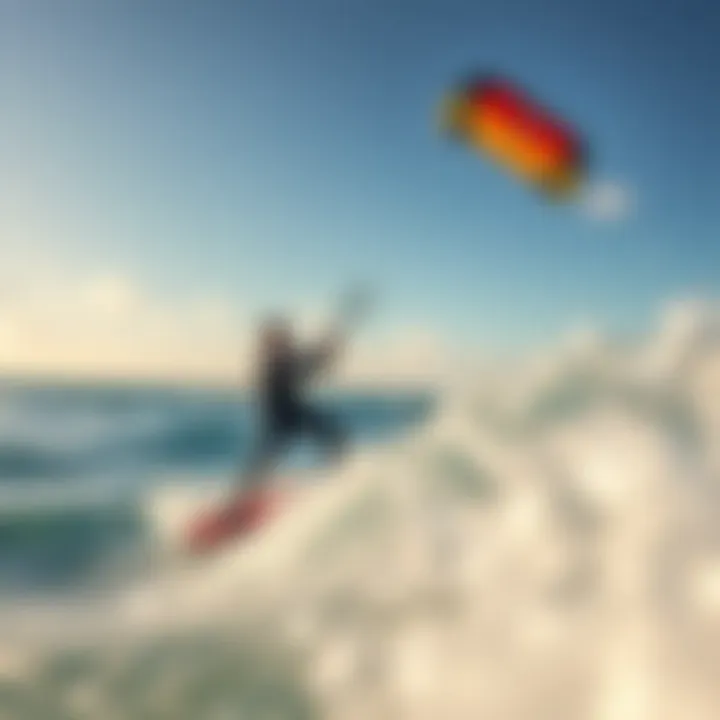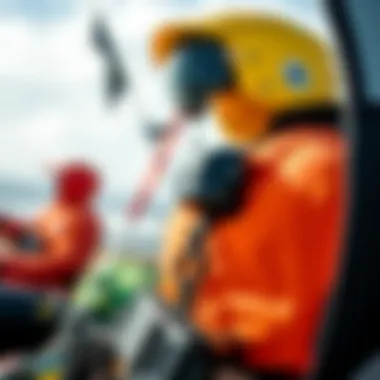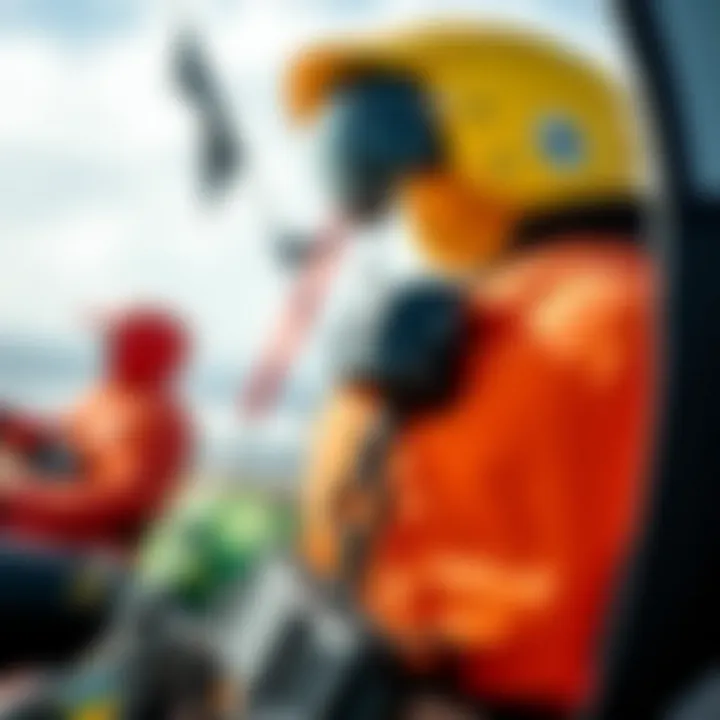Kite Insurance Company: Essential Coverage for Kiteboarders


Intro
Kiteboarding, with its exhilarating mix of speed and skill, often takes enthusiasts to the edge of the seas. Although it’s a thrilling sport, the risks that come along with it can be daunting. Whether you're catching the wind on a pristine beach or carving through waves, ensuring that you have the right protections in place is essential. This is where kite insurance steps in, acting as a safety net for both gear and the rider. Understanding the nuances of kite insurance can significantly enhance your kiteboarding experience, allowing you to focus on what you love most—riding the wind with confidence.
In this guide, we'll explore the pivotal roles that kite insurance companies play. From the various types of coverage they offer to the key factors that need consideration when selecting your policy, we aim to equip both seasoned and novice kiteboarders with the knowledge to make informed decisions. By understanding the risks inherent in kiteboarding and the legal implications of operating without insurance, one can navigate the waves and winds with a clearer mind. We'll also dive into industry standards and safety measures, empowering you to ride the waves while keeping potential calamities at bay.
Join us as we unfold the essential aspects of kite insurance—setting the groundwork for safe and enjoyable kiteboarding adventures.
Understanding Kite Insurance
Kite insurance plays a pivotal role in the ever-evolving landscape of kiteboarding, a sport encompassing not just thrill and adventure but also inherent risks. Understanding kite insurance is crucial for enthusiasts who want to enjoy their rides without the constant worry of unforeseen mishaps. This part of the article explores the essence of kite insurance and why it matters, ensuring that individuals are well-equipped to navigate the unpredictable waters of this exhilarating pastime.
Definition and Importance
Kite insurance refers to specialized coverage designed to protect kiteboarders and their gear from various liabilities and risks associated with the sport. The importance of kite insurance cannot be understated; it acts as a safety net, allowing riders to focus on the waves and wind while providing peace of mind. Whether you are a seasoned pro or a weekend warrior, understanding what kite insurance covers can save you from financial nightmares down the line.
In simple terms, kite insurance safeguards not only the rider but also protects against claims from third parties. For example, if a kiteboarder accidentally collides with another person or damages property while riding, having insurance can help mitigate the financial impact of such accidents. This coverage can also cater to personal injuries, gear loss, or damage, reinforcing the notion of safety and responsibility within the kiteboarding community.
The Unique Risks of Kiteboarding
Kiteboarding, while exhilarating, does come with its set of unique risks that differentiate it from other water sports. Understanding these risks is essential for kiteboarders to make informed decisions regarding their insurance needs. Some common risks include:
- Weather Fluctuations: Wind conditions can change abruptly, posing hazards to riders. Poor weather conditions might lead to accidents inappropriate levels of experience with the wind.
- Equipment Failure: The very gear that empowers a kiteboarder can fail. From lines snapping to faulty components, having coverage can protect against costly repairs or replacements.
- Collisions: With other watercraft, swimmers, or even wildlife in the water, the danger of crashing into something is very real. Such incidents can lead to significant injuries or damages.
- Skill-Level Variations: Not every kiteboarder has the same experience level. This disparity can lead to accidents, making liability coverage essential, especially in group settings.
This understanding of the unique risks involved in kiteboarding highlights the need for tailored insurance. By recognizing these aspects, kiteboarders can select a policy that adequately aligns with their specific needs and challenges, ensuring they are fully protected while enjoying their time on the water.
Types of Kite Insurance Coverage
When it comes to kiteboarding, having the right insurance policy can make a world of difference. Kite insurance coverage is not just an option; it's a necessity for riders seeking peace of mind while soaring over oceans and lakes. Understanding the different types of coverage available is critical, especially since the sport comes with its own set of risks. Premiums, risks, and coverage specifics vary widely, so it is important for kiteboarders to be well informed.
Liability Coverage
Liability coverage is perhaps the most essential part of any kite insurance policy. It serves as a safety net, protecting you from financial repercussions if you accidentally injure someone or damage their property while out on the water. Imagine you're having a great time, zipping around, and suddenly your kite collides with another kiteboarder or perhaps a bystander on the beach. The costs associated with medical bills or property damage can escalate quickly.
With a good liability insurance policy, riders can focus on the thrill of kiteboarding, knowing that they won't face financial ruin due to an unfortunate mishap. Depending on the provider, liability coverage can include different limits, so it’s wise to select a plan that offers adequate protection for your needs, especially if you're riding in crowded areas or hosting events.
“The peace of mind that comes with liability coverage allows you to ride freely without the nagging fear of unforeseen accidents.”
Equipment Protection
Kiteboarding gear can be remarkably expensive. From kites to boards, harnesses, and safety gear, the costs add up quickly. Equipment protection insurance is tailored to cover loss, theft, or damage to your kit. This type of coverage is especially invaluable for those who travel frequently.
Whether you’re catching waves in Hawaii or enjoying the winds of Tarifa, your equipment faces various risks, including adverse weather conditions, transportation mishaps, or even theft when you're not looking. Equipment protection not only safeguards your belongings but also allows you to replace lost or damaged items without having to shell out a fortune out of pocket.
Personal Accident Coverage
The reality is, even the most skilled kiteboarders can find themselves in precarious situations. Personal accident coverage acts as a safety blanket for riders by providing compensation for injuries sustained while engaging in the sport. This can include emergency medical expenses, rehabilitation costs, and sometimes even loss of income if a serious injury prevents you from working.
It’s crucial to read the fine print because different insurance companies have varying policies regarding what constitutes an accident. For instance, some might cover injuries from events like collisions or falls, while others may only include life-threatening situations.
This coverage is particularly important for professional kiteboarders and instructors, who are at risk of more substantial injuries due to the nature of their work. Knowing you're backed up in case of an accident can help you focus more on the thrills of kiteboarding rather than worrying about what might happen if things go south.
In summary, understanding the types of kite insurance coverage available is vital for any kiteboarder. Each coverage type—liability, equipment protection, and personal accident—offers essential benefits that can significantly enhance your kiteboarding experience while mitigating risks:
- Liability Coverage: Protect against third-party injuries or damages.
- Equipment Protection: Safeguard expensive kiteboarding gear against theft or damage.
- Personal Accident Coverage: Financial support in case of personal injuries during the sport.
Making informed decisions about your kite insurance can keep you riding with confidence, knowing that you’re fully protected against the unexpected.


Choosing the Right Policy
When it comes to kite insurance, choosing the right policy can be the make-or-break factor for any kiteboarding enthusiast. Each individual’s needs and experiences differ like day and night, making it essential to find coverage tailored to personal circumstances. A solid policy not only protects your gear but also offers peace of mind while you chase the wind.
To start, it’s crucial to assess individual needs. Considerations like how often you hit the waves, your experience level, and the regions where you kiteboard all play a role. For instance, a seasoned kiteboarder who frequently sails in rough coastal conditions warrants different coverage compared to a casual rider who enjoys flat lakes on weekends. Knowing the nuances of what you require can make all the difference in securing the right insurance.
Assessing Individual Needs
Assessing your individual needs means taking a good look at your kiteboarding lifestyle. Think about what you typically do during a session—are you just cruising or pushing the limits with advanced tricks?
- Frequency of Use: If you're on the water during every weekend, perhaps opting for an all-encompassing policy would make sense. Casual riders might settle for basic coverage.
- Location Risks: Different spots have varied hazards: rocky shores, strong currents, large crowds. Understanding these risks can help adjust your policy accordingly.
- Experience Level: Newbies may require more comprehensive coverage until they build skills and confidence.
Engage with fellow kiteboarders or local clubs for insights regarding specific needs based on personal experience and regional factors. Wouldn’t it be better to ensure you have everything covered from A to Z?
Evaluating Coverage Options
With a firm grasp of your needs, it’s time to dive into evaluating different coverage options. Policies might look complex at first glance, but breaking them down simplifies the process.
- Liability Coverage: This essential feature protects you from any incidents that may cause injury or damage to others while kiteboarding. A hefty payout can be a lifesaver in case of mishaps.
- Equipment Protection: Your gear isn't just costly; it's also a crucial part of your kiteboarding experience. Find coverage that ensures your kite, board, and safety gear are protected against theft or accidental damage.
- Personal Accident Coverage: Kiteboarding carries risks. This coverage provides financial support for medical costs associated with accidents, whether they happen in the water or on land.
Look for policies that offer flexibility to adjust coverage based on your evolving needs or frequent travel. You don’t want to get caught with inadequate protection while far from home. Research among reputable companies will often yield surprising options that align perfectly with your priorities.
Comparing Insurance Providers
Different companies have various reputations, policies, and price points. Once you’ve identified likely contenders, it’s time for a side-by-side comparison. Focus on a few key aspects:
- Reputation: Read reviews or forums such as Reddit to see what fellow riders say about their experiences.
- Claims Process: A straightforward claims process can save a mountain of headaches. Check how quickly and efficiently each provider handles claims.
- Customer Service: Responsive and knowledgeable support can make a huge difference when you encounter problems or have questions down the line.
Keep notes and weigh the pros and cons. Engaging directly with providers through calls or emails can yield insights that aren’t visible online.
In short, choosing the right policy is not a decision to take lightly. Equip yourself with information and understanding, and you will ensure that you have the kite insurance that meets your unique lifestyle and needs. Ultimately, the right insurance will not only protect you but also enhance your kiteboarding experience.
"Insurance may seem like just another line item in your budget, but when the seas get rough, it becomes your safety net. Make sure that net is strong."
Legal and Regulatory Considerations
Understanding the legal and regulatory landscape around kite insurance is vital for anyone engaged in the sport. Kiteboarding is thrilling, but it also comes with its share of risks. Legal frameworks often exist to protect both the athletes and companies offering insurance; navigating them is essential for a safe and enjoyable experience.
Insurance regulations vary greatly from one region to another, influenced by local laws, climate conditions, and even the geography of popular kiteboarding spots. Riders need to be aware of these regulations to ensure they have the right coverage and are compliant with local laws. Failing to understand these intricacies could lead not only to financial loss but also legal complications.
Insurance Regulations
Legal regulations surrounding kite insurance encompass several key aspects. They can include requirements for liability insurance, specific policies governing equipment coverage, and even mandates for personal accident insurance.
- Local Governance: Different municipalities might require proof of insurance before allowing kiteboarding activities. For instance, places like Maui or Cabarete might have distinct requirements you need to fulfill.
- Insurance Provider Licenses: Always ensure that the insurance provider you are considering is properly licensed to operate in your region. This provides a layer of safety should any claims or disputes arise.
- Transparency Mandates: Laws often dictate that insurance providers must clearly disclose what is covered and what is not. This includes exclusions that could impact your coverage when you need it the most.
Failure to adhere to these regulations could lead to significant financial repercussions, or even penalties. As an informed kiteboarder, staying updated on local statutes is just as crucial as maintaining your gear.
Liability and Claims
The issue of liability cannot be overstated in the world of kiteboarding. Knowing how liability works will protect not only you but also those who might be affected by your actions on the water.
- Understanding Liability: When kiteboarding, if an accident occurs—whether it's injuring another rider or damaging property—liability insurance can cover legal costs and claims that stem from such incidents. This is paramount for peace of mind, especially for beginners.
- Claims Process: Each insurance company will have its own procedure for filing claims. Familiarizing yourself with the necessary documentation and timelines can smooth the process, reducing stress in emergencies. For example, are you required to report an incident to local authorities, or can you go straight to your insurance provider?
- Legal Recourse: If your claim is denied or you encounter delays, knowing the legal avenues available to you can make a world of difference. Consulting local resources or legal experts familiar with insurance law can offer valuable insights on how to proceed.
"Compliance to regulations is the backbone of responsible kiteboarding. Ignorance is no excuse, especially when it comes to safety and legality."
For those who are keen to engage with the kiteboarding community, staying abreast of these legal considerations is not just about following the rules; it’s about fostering a culture of safety and responsibility. As you gear up for your next kite adventure, don't overlook the importance of these legal and regulatory frameworks. They’re not just hoop-jumping; they’re vital components of your kiteboarding experience.
The Role of Safety Protocols


Kiteboarding, while exhilarating, is not without its risks. As such, the role of safety protocols cannot be overstated. Establishing a culture of safety enhances enjoyment and can significantly reduce incidents that could compromise the kiteboarding experience. By following set guidelines and using appropriate gear, kiteboarders can navigate the challenges of the sport with more confidence.
Importance of Adhering to Safety Guidelines
When kiteboarding, following safety guidelines is like having a roadmap through uncharted waters. These guidelines provide kiteboarders with a structured approach to ensure their safety and the safety of others on the water. Ignoring these could lead to accidents, harm to personal equipment, or worse, injury to fellow riders.
- Preparedness: Being aware of local conditions, such as wind patterns and currents, is crucial. Riders should familiarize themselves with the area where they kiteboard, understanding its hazards and local laws.
- Knowledge: Kiteboarding requires both skill and knowledge. Riders should attend lessons, whether they are beginners or seasoned enthusiasts, to refine techniques and learn about situational awareness.
- Communication: Engaging in open communication with fellow riders can make or break a successful session. Hand signals and clear verbal cues help everyone stay informed about movements and intentions, thus preventing collisions.
Adhering to these guidelines forms a strong foundation for a safe kiteboarding environment.
Implementation of Safety Gear
Having the right gear is like wearing a suit of armor when facing the elements. Safety gear is essential in minimizing injuries, offering protection during mishaps, and fostering a sense of security while riding. Here are some essentials that every kiteboarder should consider:
- Helmet: A high-quality helmet protects against head injuries during falls or collisions. Choosing a well-fitted helmet designed for water sports is advisable.
- Impact Vest: This provides additional flotation and cushioning, making falls much more bearable. It’s beneficial to opt for vests designed specifically for kiteboarding.
- Floatation Devices: Consider personal flotation devices, especially for those just starting. These can assist anyone who might struggle in the water.
- Safety Leash: A crucial part of kiteboarding equipment, a safety leash prevents the kite from flying away uncontrollably and helps to keep the rider connected to the board.
"Employing safety gear may feel cumbersome at first, but it's akin to setting sail with a sturdy vessel; you wouldn't venture into rough seas without it."
Incorporating these safety measures not only protects the rider but also contributes to a safer kiteboarding community overall. It’s not just about enjoying the thrill; it’s equally about being responsible and ensuring that others can enjoy the sport just as much. The right protocols paves the way for a smooth ride, allowing kiteboarding enthusiasts to embrace the freedom of the sport while remaining safeguarded against the unpredictable nature of the sea.
For further references, you might want to check resources like Reddit Kiteboarding or specialized organizations and forums that discuss safety in kiteboarding. Whether you are a novice or an experienced kiteboarder, familiarizing yourself with safety protocols and gear is vital for ensuring your adventures are both thrilling and secure.
Environmental Considerations in Kite Insurance
Understanding the environmental factors surrounding kiteboarding is crucial, not just for the enjoyment of the sport but also for the preservation of the ecosystems we often recreate in. Kite insurance companies are increasingly incorporating environmental considerations into their policies, recognizing that they play a key role in protecting not only kiteboarders but also the natural habitats where they operate.
Sustainability in Kiteboarding
Sustainability is more than just a buzzword; in the realm of kiteboarding, it signifies a commitment to the environment and the communities surrounding popular kite spots. Freman, a well-known kiteboarding instructor in the Caribbean, often emphasizes how kiteboarding can be enjoyed without leaving a negative mark on our beloved beaches.
Some insurance companies are stepping up to include policies that encourage sustainable practices among riders. Here are a few points on sustainability related to kiteboarding:
- Eco-friendly materials: Many modern kites and boards are produced using materials like recyclable plastics or sustainably sourced fibers. Companies that promote these products often receive better coverage rates.
- Responsible riding: Riders are encouraged to respect local wildlife and flora while out on the water. Such practices can be integrated within insurance policies, resulting in lower premium costs for those who adhere to them.
- Environmental contributions: Some kite insurance providers might partner with NGOs to plant trees or clean beaches for every policy sold, fostering a mutual benefit for the sport and the environment.
Engaging in kiteboarding sustainably plays a vital role in maintaining the natural beauty and integrity of our oceans and coastlines. When riders take steps to reduce their environmental impact, they’re not just protecting their favorite playground—they're also paving the way for future generations to enjoy these same experiences.
Impact of Kiteboarding on Natural Habitats
Kiteboarding, while exhilarating, impacts the surrounding environment, and understanding this interaction is essential. Waves crashing and kites billowing in the wind can disrupt marine wildlife, particularly during breeding seasons.
Here are a few ways kiteboarding can impact natural habitats:
- Disturbance to Wildlife: Birds and marine animals may be startled or scared away by kiteboarders, leading to decreased nesting success or foraging opportunities.
- Erosion of Coastal Areas: Repeated use of the same launch and landing spots can lead to erosion and further degradation of coastal landscapes. Insurance policies may promote the use of designated areas to minimize such impacts.
- Water Quality Concerns: With increased popularity, the concentration of kiteboarders can lead to littering, pollution, and other forms of environmental degradation. Effective kite insurance should highlight policies that support clean-ups and environmental education programs.
To mitigate these impacts, eco-conscious kiteboarders can adopt a 'leave no trace' philosophy. Ensuring that natural habitats are preserved means the sport can continue to thrive without harming the environments we cherish.
"The real test of a kiteboarder’s skills lies not in their tricks, but in their ability to coexist harmoniously with the delicate ecosystems they enjoy."
Industry Standards and Best Practices
Navigating the world of kite insurance can be tricky. For kiteboarders, it’s not just about hitting the waves. Understanding industry standards and best practices in kite insurance can mean the difference between enjoying a smooth ride and facing unexpected hiccups. These guidelines shape how insurance companies craft their policies and help riders choose the right coverage.
Industry standards ensure that kiteboarding insurance is both comprehensive and relevant. It sets a benchmark for what a good policy should cover, which includes liability protection, gear coverage, and personal accident protection. In an unpredictable sport like kiteboarding, being aware of these standards can offer peace of mind.
Some key elements often highlighted include:
- Coverage Adequacy: Does the policy cover common incidents?
- Accessibility: Can riders easily access their insurance when needed?
- Clarity: Are the terms straightforward, avoiding confusing jargon?
By aligning with industry standards, insurance providers can better cater to the unique challenges kiteboarders face, improving overall safety and security for the sport.


Benchmarking Policies
When it comes to kite insurance, benchmarking policies plays a crucial part in ensuring comprehensive protection. It involves assessing various insurance offerings against best practices or common benchmarks. This helps riders identify suitable options that meet their specific needs.
For kiteboarders, benchmarking might involve:
- Comparing coverage limits: Look at different policies to see which offers higher coverage for similar premiums.
- Checking past claim reports: Research how different companies respond to claims. A company with a good track record tends to be more reliable.
- Reading reviews and testimonials: Getting insights from fellow kiteboarders who have dealt with specific insurers can help gauge a provider’s trustworthiness.
By benchmarking, riders equip themselves to make informed decisions, ensuring they choose a policy that not only meets regulations but also adequately covers potential risks.
Adopting Innovations in Coverage
In a rapidly evolving insurance landscape, adopting innovations in coverage is vital for kiteboarding enthusiasts. As technology advances, so do the products available on the market. Riders should stay informed about emerging trends in insurance to get the best possible protection.
Some noteworthy innovations to consider include:
- Telematics Usage: Some insurers are now incorporating telematics, which uses technology to track riding habits. This data can lead to personalized coverage and might lower premiums for safe riders.
- On-Demand Policies: As the gig economy grows, on-demand insurance options are blossoming. These flexible policies allow riders to get coverage for a specific event or day, making them economical and convenient.
- Risk Assessment Tools: New tools help assess risks more accurately, from environmental conditions to rider behavior, allowing insurers to tailor policies better based on individual needs.
Embracing these innovations means kiteboarders can ensure their insurance remains relevant and adequately protective as the sport continues to evolve.
"Kiteboarding is not just a sport but an adventure sport with inherent risks. Make sure your insurance keeps pace with your passions."
For further insights into kite insurance and best practices, consider visiting resources like Wikipedia or Edmunds which often have in-depth articles on insurance standards. Also, rider forums on Reddit provide generous sharing of personal experiences and issues, highlighting practical realities that canguide your decisions.
Kite Insurance and International Travel
When kiteboarding enthusiasts set their sights on foreign shores, it’s essential not to overlook the nuances of kite insurance. Traveling internationally can be a thrilling experience, but it brings unique challenges and risks. That’s why understanding kite insurance in the context of international travel is pivotal for every kiter.
Considerations for International Riders
Navigating the world of kiteboarding across borders involves more than just packing gear and booking flights. Here are a few key considerations:
- Insurance Coverage Validity: Policies may vary widely depending on the region. Always check whether your domestic kite insurance extends to international destinations. Some insurers might have a clause restricting coverage outside a specific geographic area, leaving riders vulnerable.
- Local Regulations: Different countries have distinct regulations governing water sports. Ensuring your insurance covers any legal liabilities that may arise due to those regulations is important. For instance, if a kiter harms another person or damages property while riding in a foreign country, they could face substantial legal fees and personal claims without the right coverage.
- Risk Assessment: Have a clear understanding of the kiteboarding spots you intend to visit. Not all locations are created equal; some might pose higher risks due to environmental conditions or inadequate safety measures. Make sure your policy accounts for these factors, which might require additional riders or amendments to your coverage.
- Rescue Services and Emergency Support: In far-off locations, access to emergency services can vary significantly. Consider insurance that includes emergency rescue and medical coverage, as a precaution for unforeseen events.
"Being prepared can make the difference between a trip of a lifetime and a costly disaster."
- Weather Considerations: Different regions come with their own set of weather patterns that can affect kiteboarding activities. International riders must be informed about local weather conditions and ensure that their insurance will cover any cancellations or trip interruptions resulting from severe weather.
Global Insurance Trends
The kite insurance landscape is evolving, influenced by various factors impacting the global kiteboarding community. Some noteworthy trends include:
- Technological Integration: More insurers are embracing technology, offering streamlined processes for purchasing and managing kite insurance policies. Some apps even allow riders to document their kiteboarding events, linking claims directly to specific sessions, making it easier to manage risks associated with their adventures.
- Customization of Policies: Riders are increasingly seeking tailored insurance solutions. Customization often includes options for specific high-risk activities, which is particularly useful for those participating in competitions or events abroad.
- Focus on Sustainability: The push towards eco-friendly practices is making waves in the insurance industry as well. Some companies are developing policies that not only cover kiteboarding but also promote sustainable kiteboarding practices, such as supporting local conservation efforts in the areas where riders frequent.
- Increased Awareness and Education: With the rise of social media and online communities, there’s been a significant increase in awareness surrounding kite insurance. Riders are more informed about the importance of having adequate coverage, encouraging them to seek out policies that truly meet their needs.
In summary, venturing abroad with a kiteboard in tow requires sound knowledge of the insurance landscape. Making sure that you have the right cover can lead to a worry-free experience, allowing enthusiasts to focus on what they love most—riding the wind and waves. For further insight into the significance of insurance while traveling, consider checking resources from industry experts, such as Kiteboarding.com or community forums on Reddit that discuss the latest happenings in kite insurance.
The Future of Kite Insurance
The landscape of kite insurance is shifting as the sport evolves and new technologies make waves. Understanding the future of kite insurance is crucial for athletes, instructors, and event organizers alike. As kiteboarding gains popularity, the need for comprehensive coverage becomes more pressing. Anticipating the changes in how insurance is structured allows kiteboarders to better protect themselves and their equipment. Companies focusing on innovations in coverage patterns and digital tools will likely pave the way forward, making it easier to navigate the insurance waters.
Innovations in Insurance Technology
Advancements in technology are making a tangible impact in the insurance industry, including kite insurance. Just imagine a world where you can manage your insurance policy with the tap of a finger. Insurtech startups are developing apps that allow riders to customize coverage options in real-time, based on their specific needs or planned locations. This convenience can increase accessibility for both new and experienced kiteboarders.
Telematics is another area where innovation is catching attention. By utilizing GPS data and wearable tech, insurers can evaluate risk more accurately. By knowing where the kiteboarders ride and what conditions they encounter, they can offer tailored premiums that reflect the actual risk level. This data-driven approach empowers policyholders while enhancing the whole coverage experience. It’s a move toward more transparent and rather personalized insurance solutions.
Trends Shaping the Industry
Several trends are on the horizon that will likely shape the future of kite insurance. A growing emphasis on sustainability in kiteboarding means there’s a rising demand for eco-friendly policies. Insurers are starting to recognize the importance of aligning their services with the values of environmentally-conscious kiteboarders. Policies that promote sustainable practices or provide incentives for eco-friendly gear could become commonplace.
Another trend is the shift towards a more global framework in insurance. As kiteboarding spots are spread around the world, international riders often find themselves needing coverage that extends beyond local realms. More companies are recognizing the need for policies that offer adequate protection when traveling, effectively bridging gaps in coverage for kite enthusiasts who chase the wind around the globe.
The future of kite insurance hinges on technology and trends that focus on personalized, transparent, and sustainable practices, ensuring all kiteboarders can ride with confidence.
With these developments, it’s clear that kite insurance is not simply a static element of the sport but an evolving necessity. As these innovations and trends take root, kiteboarders must stay informed and prepared for a landscape that is more accommodating to their adventurous spirit. Useful resources like Wikipedia about Kiteboarding or forums such as Reddit can provide valuable insights into new coverage options and community experiences.















